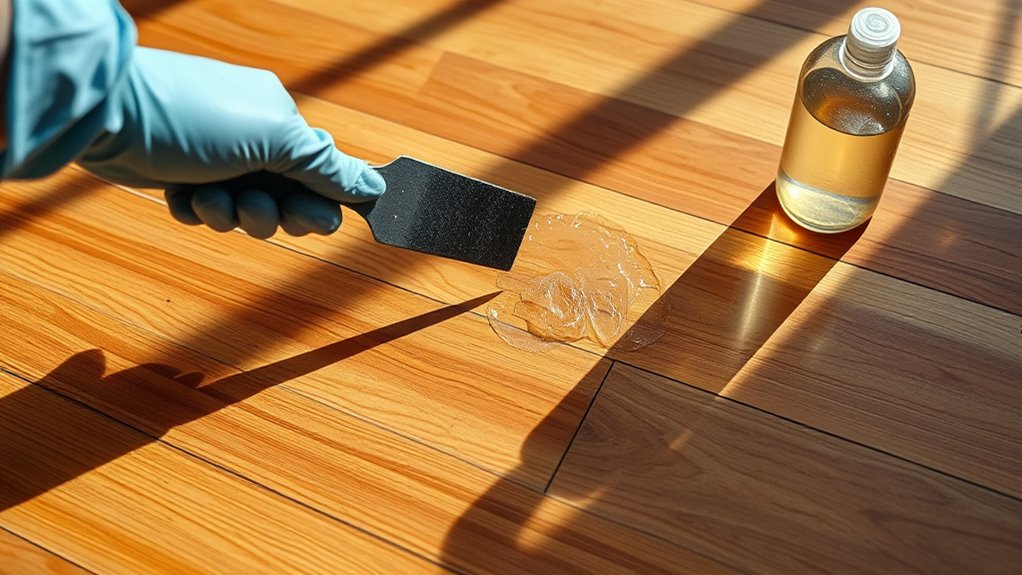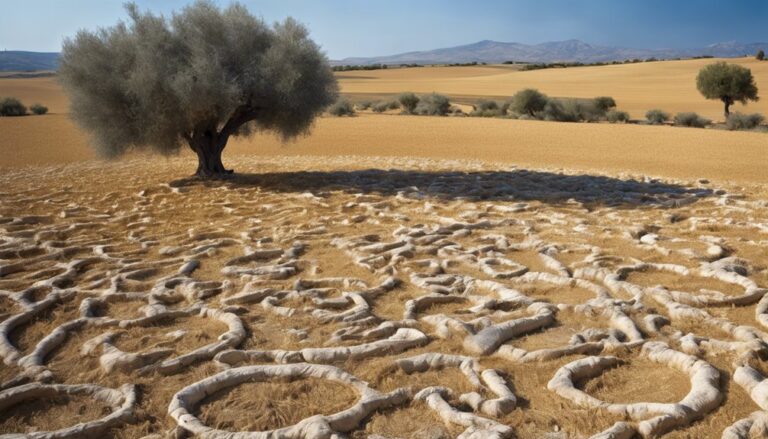To get glue off your wood floor, first identify the glue type and gather mild cleaning supplies like warm soapy water, vinegar, or rubbing alcohol. Test your chosen method on a hidden spot to avoid damage. For fresh glue, gently wipe with soapy water; for dried glue, soften it with vinegar or alcohol before using a plastic scraper at a low angle to avoid scratching. Finish by cleaning and drying the floor thoroughly. For detailed steps and safety tips, keep exploring effective removal techniques.
Identify the Type of Glue on Your Wood Floor
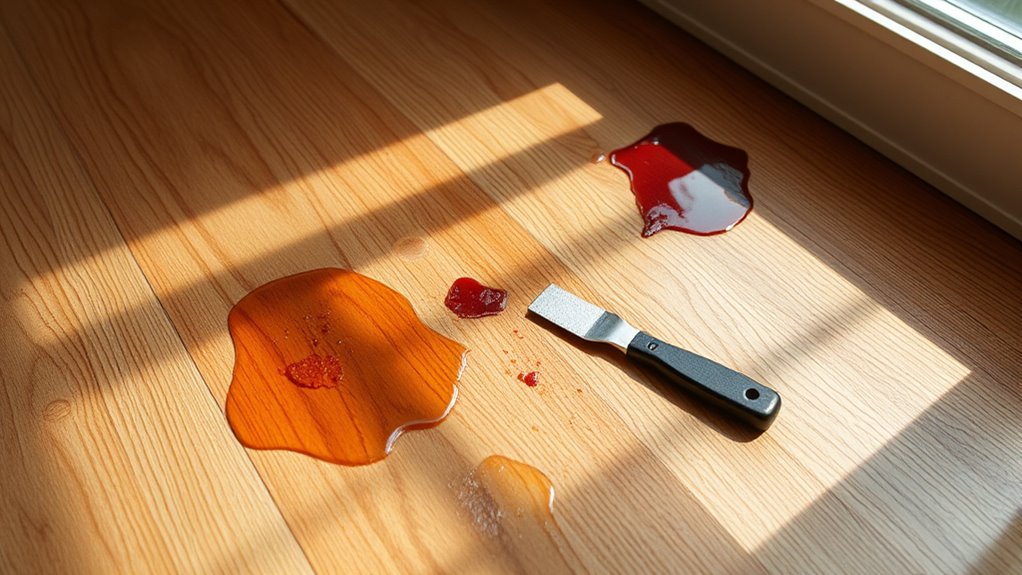
How can you effectively remove glue from your wood floor if you don’t know what type it is? Start by examining the glue’s characteristics—its color, texture, and how firmly it adheres. Different types of adhesives, like water-based glues, epoxy, or polyurethane, each require specific removal methods. For example, water-based glue is often softer and easier to dissolve, while epoxy is hard and resistant. Consider how long the glue has been on the surface; older glue tends to harden and bond more strongly. Knowing these glue characteristics helps you choose the right approach without damaging your wood floor. Taking the time to identify the adhesive type gives you the freedom to tackle the problem efficiently and avoid trial-and-error methods that waste time and risk harm.
Gather Necessary Tools and Materials
Before you start removing glue, make sure you have essential cleaning supplies like a putty knife, mild adhesive remover, and soft cloths. Don’t forget protective gear such as gloves and goggles to keep yourself safe during the process. Choose products specifically designed for wood floors to avoid damaging the finish.
Essential Cleaning Supplies
Removing glue from a wood floor requires specific tools and materials to guarantee the job is done effectively without damaging the surface. Start by identifying the adhesive types to select the right cleaning solutions. For water-based glues, mild soapy water usually works, while stubborn or solvent-based adhesives may need stronger agents like rubbing alcohol or acetone. Gather a plastic scraper to gently lift glue without scratching, microfiber cloths for wiping, and a soft-bristle brush to tackle stubborn spots. Have a bucket for mixing cleaning solutions and paper towels for quick absorption. Avoid abrasive tools that can harm the wood finish. Being methodical with these essential cleaning supplies ensures you maintain your floor’s integrity while efficiently removing any adhesive residue.
Protective Gear Needed
Three key pieces of protective gear you’ll need are gloves, safety glasses, and a mask. Start with rubber gloves to shield your hands from harsh chemicals and sticky glue residue. These gloves guarantee your skin stays safe and dry. Next, put on safety goggles or safety glasses to protect your eyes from splashes or airborne particles during cleaning. Your eyes are vulnerable, so don’t skip this step. Finally, wear a mask to avoid inhaling fumes from solvents or adhesives, especially in confined spaces. This simple trio keeps you safe and comfortable, letting you work confidently and freely. Preparing with the right protective gear is essential before tackling glue removal on your wood floor. Stay protected, then proceed with care.
Choosing Wood-Friendly Products
With your protective gear on, the next step is selecting products that won’t damage your wood floor. Start by choosing wood safe solvents designed specifically for adhesive removal. Avoid harsh chemicals like acetone or bleach, as they can strip the finish or discolor the wood. Instead, opt for eco friendly cleaners that are gentle yet effective, minimizing environmental impact while preserving your floor’s integrity. Check product labels for natural ingredients and non-toxic certifications. Gather a soft cloth, a plastic scraper, and a small bowl for diluting solutions if needed. Having these tools ready guarantees a controlled, precise application. By carefully selecting these wood-friendly products, you maintain your floor’s beauty and enjoy the freedom to clean without worry or damage.
Test a Small, Hidden Area First
Before applying any cleaning solution or adhesive remover to your wood floor, you should test it on a small, hidden spot. Hidden area testing guarantees the product won’t damage the finish, discolor the wood, or cause warping. Choose a discreet section, like under furniture or near a baseboard, and apply a small amount of the chosen remover. Wait several minutes to observe any adverse reactions. This step is essential to avoid costly mistakes and preserve your floor’s integrity. By methodically testing glue removal techniques in a contained area, you gain confidence that your approach is safe and effective. Skipping this can lead to permanent damage, limiting your freedom to restore the floor without professional help or expensive refinishing. Always prioritize hidden area testing for a successful glue removal process.
Use Warm Soapy Water for Fresh Glue
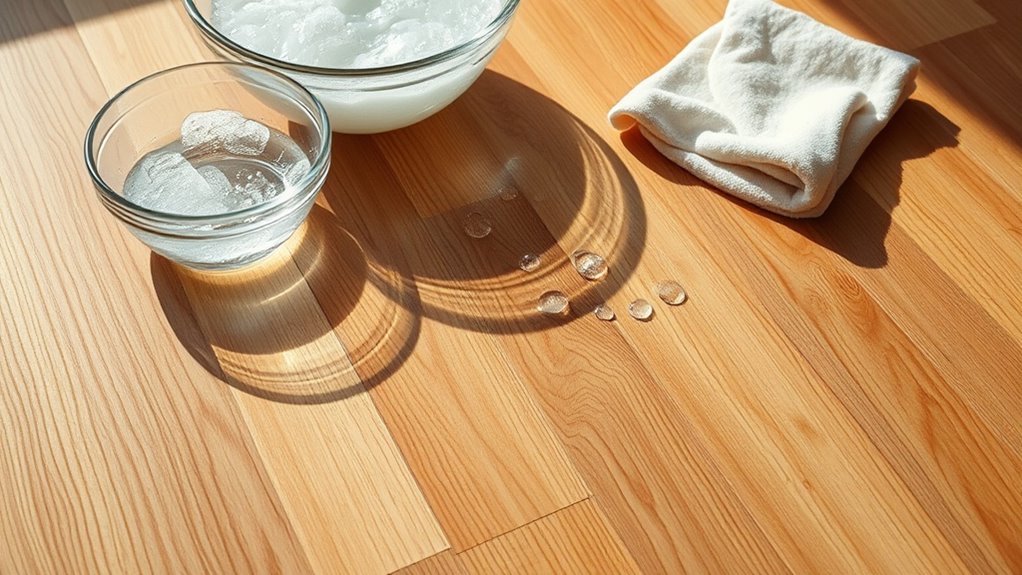
Start by mixing warm water with a mild soap to create a gentle cleaning solution. Use a soft cloth or sponge to carefully scrub the fresh glue without damaging the wood. Once the glue loosens, wipe the area clean and dry it thoroughly to prevent moisture damage.
Prepare Warm Soapy Solution
Although fresh glue is easier to remove, you’ll want to act quickly by preparing a warm soapy solution. This simple mixture softens the adhesive, making removal less of a chore and preserving your wood floor’s finish.
To prepare your solution:
- Fill a bucket or bowl with warm water — not too hot, to avoid damaging the wood.
- Add a few drops of mild dish soap to the water, stirring gently until it’s well mixed.
- Test the solution on a small, hidden area of the floor to verify it won’t cause discoloration or damage.
With this ready, you’re set to tackle the glue confidently, using a method that respects your floor’s integrity while freeing you from sticky messes.
Gently Scrub Glue Area
Carefully scrub the glue area using a soft cloth or sponge dampened with your warm soapy solution. Focus on gentle scrubbing techniques to avoid damaging the wood floor’s surface. Apply consistent, circular motions, allowing the soapy water to soften the glue. Avoid harsh scrubbing or abrasive tools, as they can scratch or dull the finish. If the glue starts to loosen, continue with light pressure until it lifts from the wood. For stubborn spots, dip the cloth back into the warm soapy water and repeat the process. This methodical approach guarantees effective glue removal while preserving your floor’s integrity. Remember, patience and controlled scrubbing techniques are key to freeing your wood floor from fresh glue without causing harm.
Wipe Clean and Dry
Once the glue has softened and lifted, you’ll want to wipe the area clean with a cloth dampened in warm soapy water. This step removes residue and prepares the surface for drying. Use effective wipe techniques to avoid spreading glue or damaging the wood finish. Follow these steps:
- Gently wipe in a circular motion, ensuring all softened glue is removed without excessive moisture.
- Rinse the cloth frequently with warm soapy water to maintain cleaning efficiency.
- Employ drying methods like using a dry microfiber cloth or allowing air circulation to eliminate moisture quickly.
Apply Vinegar or Rubbing Alcohol for Dried Adhesive
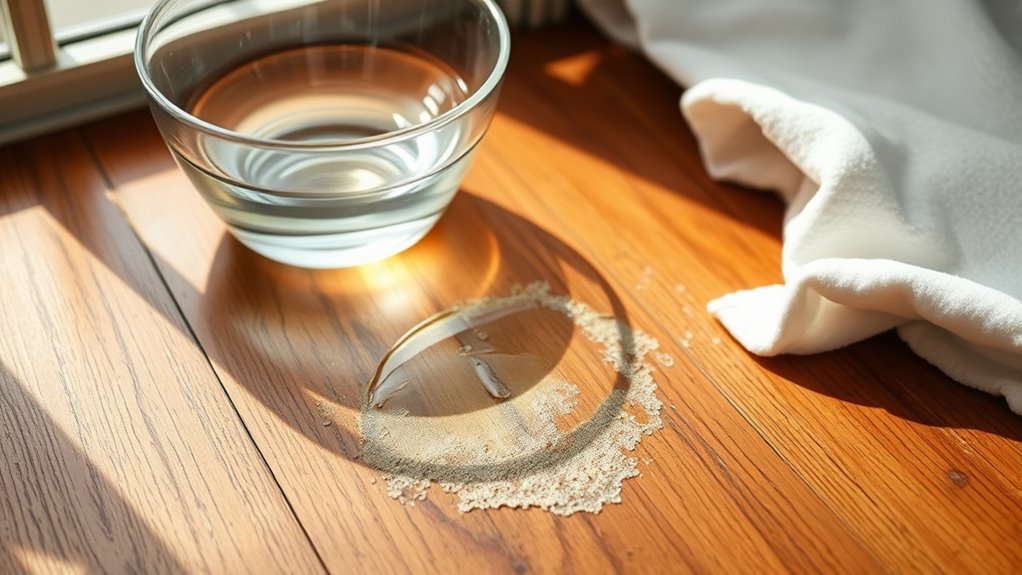
Two common household liquids, vinegar and rubbing alcohol, can effectively break down dried glue on wood floors without causing damage. Start by mixing a vinegar solution—equal parts white vinegar and water—and apply it to the glue with a clean cloth. Let it sit for 5 to 10 minutes to soften the adhesive. Alternatively, you can use rubbing alcohol directly on the glue spot. Dab a small amount onto a cloth and press it onto the dried glue, allowing it to penetrate for several minutes. After the glue softens, gently scrape it off with a plastic scraper or your fingernail. Always test the vinegar solution or rubbing alcohol on a hidden area first to verify no discoloration occurs. This method gives you control and preserves the wood’s finish while removing stubborn adhesive.
Try Commercial Glue Removers Safely
Although household solutions work for many cases, you might find commercial glue removers more effective for stubborn or large glue spots on wood floors. When choosing commercial products, prioritize safe application to protect your floor’s finish and your health. Here’s how to proceed:
- Read Labels Thoroughly – Confirm the remover is compatible with wood flooring and follow all safety instructions.
- Test in an Inconspicuous Area – Apply a small amount first to check for any discoloration or damage before full use.
- Use Sparingly and Ventilate – Apply only as much as needed and keep the area well-ventilated to avoid inhaling fumes.
Scrape off Glue Gently With a Plastic Scraper
Start by carefully scraping off the softened glue using a plastic scraper to avoid damaging your wood floor. Use gentle scraping techniques, holding the scraper at a low angle to lift glue without gouging the surface. Avoid metal tools that can leave scratches. Work slowly and methodically, focusing on small sections to maintain control.
| Tool Used | Purpose |
|---|---|
| Plastic Scraper | Safe glue removal without damage |
| Soft Cloth | Wipe loosened glue residue |
| Warm Water | Soften glue for easier scraping |
| Patience | Prevent floor damage |
Clean and Restore the Wood Floor Finish
Once you’ve carefully removed the glue residue with a plastic scraper, you’ll need to clean and restore the wood floor finish to bring back its original luster. Proper wood floor restoration guarantees your floor looks natural while maintaining durability. Follow these steps for effective finish maintenance:
After removing glue residue, clean and restore your wood floor finish to maintain its natural look and durability.
- Clean Thoroughly: Use a hardwood floor cleaner or a mixture of mild soap and water to remove any leftover adhesive and dirt. Avoid excess water to prevent damage.
- Dry Completely: Wipe the floor dry with a soft cloth to prevent moisture from seeping into the wood.
- Restore the Finish: Apply a compatible wood floor polish or refinisher to rejuvenate the surface. Follow product instructions for best results.

